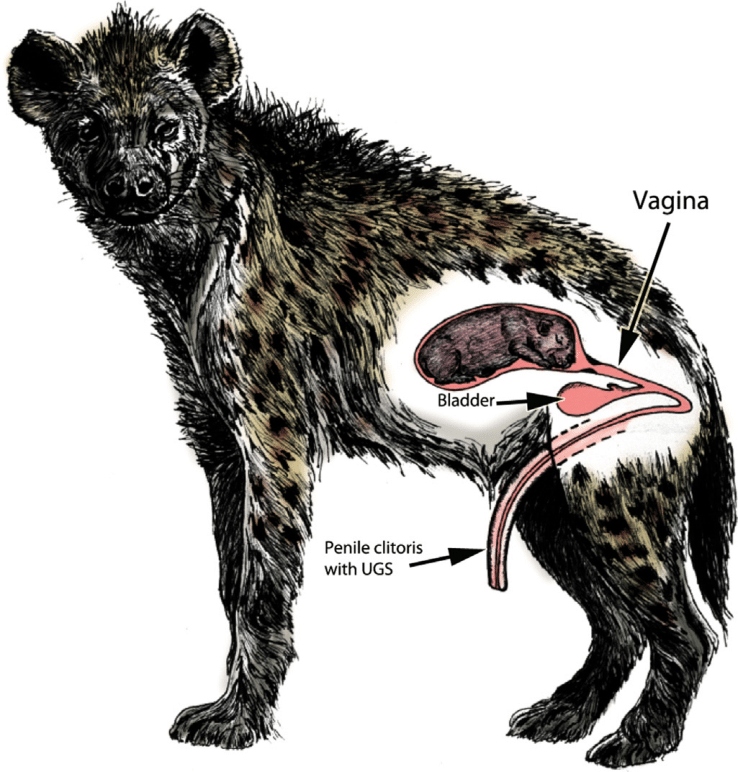Nature is full of fascinating and sometimes brutal adaptations, but few are as shocking as the birthing process of the spotted hyena. You might think childbirth is a universally painful experience, but hyenas take it to an entirely new level.
Female hyenas have one of the most unusual reproductive anatomies in the animal kingdom—what appears to be a penis is actually an elongated clitoris, known as a pseudo-penis. This rare adaptation makes mating, birth, and survival incredibly difficult for both mother and cubs.
Let’s dive into the science, struggles, and evolutionary mysteries behind why hyenas experience one of the most challenging births in the wild.
Hyenas’ Unique Reproductive Anatomy: A Bizarre Evolutionary Twist

The female spotted hyena (Crocuta crocuta) is unlike any other mammal when it comes to reproduction. Unlike most female mammals, hyenas have no external vaginal opening. Instead, their labia are fused together, forming a pseudo-scrotum, and their clitoris is elongated into what resembles a fully functional penis.
This means that both mating and giving birth happen through a narrow, tough, and inflexible canal—a structure that poses serious risks to both mother and cubs.
But why would evolution favor such an extreme adaptation? The answer lies in hyena social structure and dominance.
The Link Between Dominance and Reproductive Anatomy
Hyenas live in strict matriarchal societies, where females outrank males in dominance. The unusual reproductive anatomy is believed to be an evolutionary adaptation linked to social hierarchy.
- A Display of Strength: A larger pseudo-penis might act as a dominance signal, making it clear which females hold power in the clan.
- Hormonal Influence: Female hyenas have higher testosterone levels than males, leading to increased aggression and dominance over the pack.
- Mating Challenges: Males must earn the right to mate, as females control copulation with their complicated anatomy.
Video : Hyenas’ Brutal Birth: The Most Painful Labor in the Animal Kingdom
While this system gives females power, it comes at a terrible cost when it’s time to give birth.
Why Giving Birth Is So Dangerous for Hyenas
Imagine trying to push a newborn through a passage too small, too rigid, and highly prone to tearing. That’s exactly what female hyenas go through every time they give birth.
Here’s what makes hyena birth so deadly:
- A Super Tight Birth Canal
- The pseudo-penis acts as the only birth canal, but it is long, narrow, and lacks the elasticity of a normal vagina.
- This makes labor extremely difficult and painful, with a high chance of the tissue tearing.
- First-Time Mothers Face the Worst Risks
- Many first-time mothers do not survive the birthing process due to severe ruptures.
- Those who do survive often suffer from long-term damage to their reproductive organs.
- High Cub Mortality Rate
- A staggering 60% of hyena cubs suffocate before they are fully delivered.
- Since the birth canal is so tight, cubs often become trapped and die before they can emerge.
- A Painful Recovery Process
- After birth, the pseudo-penis often ruptures completely, forcing it to heal over time.
- Mothers suffer weeks of pain and vulnerability while their bodies recover.
Despite these brutal challenges, hyenas continue to thrive, and their unique reproductive system has remained largely unchanged for millions of years.
How Do Hyenas Mate? The Struggles of Reproduction

If you think birth is difficult for hyenas, mating is no easier. Males must overcome significant anatomical and social obstacles just to reproduce.
- Males Are Submissive to Females
- Unlike in many species where males dominate, male hyenas are the weaker sex in both power and ranking.
- They must approach females cautiously, often displaying submissive behavior to gain approval.
- Navigating the Pseudo-Penis
- Since females have no traditional vaginal opening, males must carefully maneuver through the pseudo-penis to copulate successfully.
- This requires both patience and precise positioning, making it one of the most complex mating processes in the animal world.
- Only the Strongest Males Get to Reproduce
- Males don’t fight each other for dominance like in other species. Instead, they must earn the female’s trust over time.
- Females choose mates based on persistence, patience, and respect, ensuring only the most determined males pass on their genes.

Given how dangerous and inefficient the reproductive process is for hyenas, one might wonder why evolution hasn’t corrected this issue.
The answer lies in survival strategy and social dynamics.
- Matriarchal Control Guarantees Stronger Cubs
- By limiting mating to only the most persistent males, female hyenas ensure that their cubs inherit strong genetics.
- This method prevents weaker genes from spreading, keeping the species robust.
- Higher Testosterone Helps With Survival
- The same high testosterone that makes birth difficult also makes female hyenas stronger and more aggressive.
- This aggression helps protect their cubs and maintain dominance in their environment.
- Fewer Cubs = More Resources
- Since many cubs don’t survive birth, the ones that do are often given more attention and resources.
- This ensures the strongest cubs make it to adulthood, increasing the clan’s overall survival rate.
The Resilience of the Spotted Hyena
Despite their brutal birthing process, hyenas have thrived for millions of years. Their ability to adapt, dominate, and survive proves just how powerful evolutionary trade-offs can be.
- They are among Africa’s most successful predators, competing with lions for food.
- Their clans are ruled by powerful females, ensuring only the strongest members survive.
- They have some of the most advanced social structures in the animal kingdom, making them highly intelligent and strategic.
Video : The Most Extreme Births In The Animal Kingdom
Conclusion: Nature’s Ultimate Test of Survival
Hyenas are proof that nature often prioritizes survival over comfort. Their unique reproductive anatomy, extreme birthing challenges, and dominance-driven society have allowed them to thrive despite overwhelming odds.
While their birth process remains one of the most painful and deadly in the animal kingdom, it also ensures that only the strongest females and cubs survive.
So the next time you see a spotted hyena, remember—they’re not just fierce scavengers. They’re survivors of one of evolution’s toughest reproductive challenges.
This Retired Icon Was One of the Sexiest Women of the 20th Century, Secretly Married, & Disappeared for Years

On her 89th birthday, French legend Brigitte Bardot was spotted for the first time in a long time.
The celebrity has been with her loving husband for 31 years, and he never leaves her side.
News outlets claim that the movie star, who experienced a health crisis earlier this year, got married in secret to her husband.
As the entertainment industry’s “it” girl for eternity, Brigitte Bardot, a French superstar, led a colorful existence. Her famous roles in multiple silver screen productions have earned her recognition and admiration.
The French blonde beauty topped the list of the prettiest female stars of the 20th century thanks to Playboy, which is well-known for its features and displays of gorgeous famous ladies. She is even considered the greatest “It” girl of all time by other media sources.

Brigitte ranks fourth on Playboy’s list of the sexiest female stars, but aside from her attractive appearance, she’s also well-known for her pouty lips. She was also named the most watched star in her native nation due to her seductive charisma and sexy confidence.
Brigitte has established a reputation as a passionate animal rights activist in addition to her achievements as an actor and general performer. Regarding her personal life, the well-liked celebrity, also known by her stage as BB, has been married to Bernard d’Ormale for 31 years and has a single child.
Few friends joined the couple for their special day as they secretly tied the wedding in August 1992, according to media agencies. Since then, the couple has been happy together. When Brigitte and Bernard got married unexpectedly and covertly, acquaintances of the “Contempt” star said to a news outlet that she was happiest than she had been in a long time.
Remarkably, Brigitte’s acquaintances had doubted that she would marry again after her previous spouse died. This was before the two got married. Nevertheless, the couple was married in a charming little wooden chapel in Norway and shared Brigitte’s opulent ten-bedroom house in Saint-Tropez.
Bernard has been Brigitte’s support system since their first meeting, notably throughout her health crises. Brigitte’s hero instantly calmed the extremely alarmed people when it was initially revealed in French media that their much-loved star had supposedly overdosed on sedatives in 1992 while at home by explaining:
Brigitte was so exhausted that she overindulged in medicine in an attempt to fall asleep.She was OK after a few hours and did not have her stomach pumped.
Brigitte’s condition was further verified by a representative of the clinic where she was brought, confirming Bernard’s claim. But Brigitte had to deal with another health issue years after her sedative fright.
Bernard verified that Brigitte had trouble breathing earlier this year. Fortunately, emergency responders saw to it right away, giving her oxygen and staying with her to make sure she was okay.
Bernard attributed his wife’s respiratory issues on aging and weather-related factors, mentioning a severe heatwave that was at the time affecting most of Europe. It seemed that their La Madrague home’s air conditioning system was not operating at its best.
A news outlet had claimed that Brigitte had remained in the intensive care unit (ICU) despite assurances to the public to the contrary. But the “A Very Private Affair” star corrected the record in a handwritten note:
“I would like to reassure everyone.” I am doing excellently. I was sick, and the press made a big deal out of it.
The beloved figure was recently observed out and about in an unusual appearance. Earlier this year, the icon suffered respiratory issues. Brigitte was photographed by paparazzi enjoying a drive in the South of France on her 89th birthday.
From her La Madrague house to her La Garigue residence, the actress was spotted traveling in a tiny white van. Only a few stray strands of her renowned blond hair framed her face because it was fastened back. She was also wearing large sunglasses to protect her eyes from the sun.
A few months after emergency personnel arrived at Brigitte’s house to help her with her respiratory problems and several years after she was last spotted in public, the uncommon outing occurs.



Leave a Reply